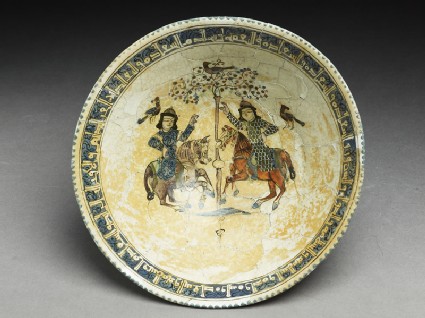Search Results: objects
Show search help- Reference URL
Actions
Bowl with paired riders inscribed with good wishes
-
Details
- Associated place
- Date
- late 12th century - early 13th century
- Material and technique
- fritware, with overglaze enamels
- Dimensions
-
8.3 cm (height)
19.5 cm (diameter)
- Material index
- Technique index
- Object type index
- No. of items
- 1
- Credit line
- Presented by Sir Alan Barlow, 1956.
- Accession no.
- EA1956.36
-
Further reading
Allan, James W., Islamic Ceramics, Ashmolean-Christie's Handbooks (Oxford: Ashmolean Museum, 1991), no. 14 on p. 26, illus. p. 27
Fehérvári, Géza, Islamic Pottery: A Comprehensive Study Based on the Barlow Collection (London: Faber and Faber, 1973), no. 121 on p. 101, pl. H (colour)
Allan, James W., Medieval Middle Eastern Pottery (Oxford: Ashmolean Museum, 1971), p. 30, illus. p. 31 pl. 26
Glossary
fritware
-
fritware
Ceramic material composed of ground quartz and small quantities of clay and finely ground frit (frit is obtained by pouring molten glass into water).
Location
Objects are sometimes moved to a different location. Our object location data is usually updated on a monthly basis. Contact the Jameel Study Centre if you are planning to visit the museum to see a particular object on display, or would like to arrange an appointment to see an object in our reserve collections.
Collection trails
Galleries
Publications online
-

Islamic Ceramics
Book painting, both illumination and illustration, had a marked impact on the decorative ceramic tradition of the Islamic Near East in the twelfth and thirteenth centuries. The underglaze-painting technique (see no. 10 [EA1978.2311]) had one serious limitation – colour: it was confined to blue and black. In northern Iran, probably in Kashan, was developed the technique of overglaze painting, painting onto the cold glaze with enamel colours which were then fixed in a final, low temperature firing. This enabled the potters to copy and develop the more highly-coloured, artistic ideas already in use among book painters. Objects decorated in the overglaze technique are normally called Minai-ware, from the Arabic word mina, ‘glaze’.
On the upper bowl [EAX.3102] the blue is under the glaze, the gold and red over it. The central geometric design is probably inspired by a Quranic frontispiece, while the gilded letters, their red outlines, and the four ornamental dividers can also be compared to the calligraphy and illumination of luxuriant Quranic manuscripts. The words on the inside of the rim, in kufic geometric script, are purely ornamental. Those in cursive script on the inside of the body, on the other hand, wish the owner good fortune, using such sentiments as eternal glory, increasing prosperity, happiness, peace, generosity and perpetuity!
In contrast, the two figures on the lower bowl [EA1956.36] most probably derive from textile designs, in which symmetrical compositions have great technical, and therefore economic, advantages. Moreover, paired horsemen or paired, confronted animals and birds, are common on surviving, early Islamic silks. ‘Minai’ ware was thus drawing not only on illuminated manuscripts, but also on contemporary luxury textiles.
The two figures are probably not part of any specific story or legend. More likely they are to be seen as symbols of the ease and well-being that accompany the courtly life. Their symbolic message is then enhanced by the words of good fortune - peace, well-being, joy, happiness and so on, on the inside of the rim.
© 2013 University of Oxford - Ashmolean Museum












